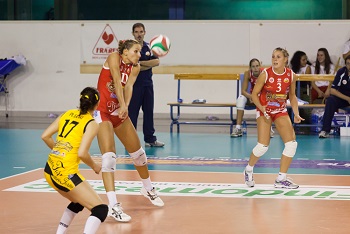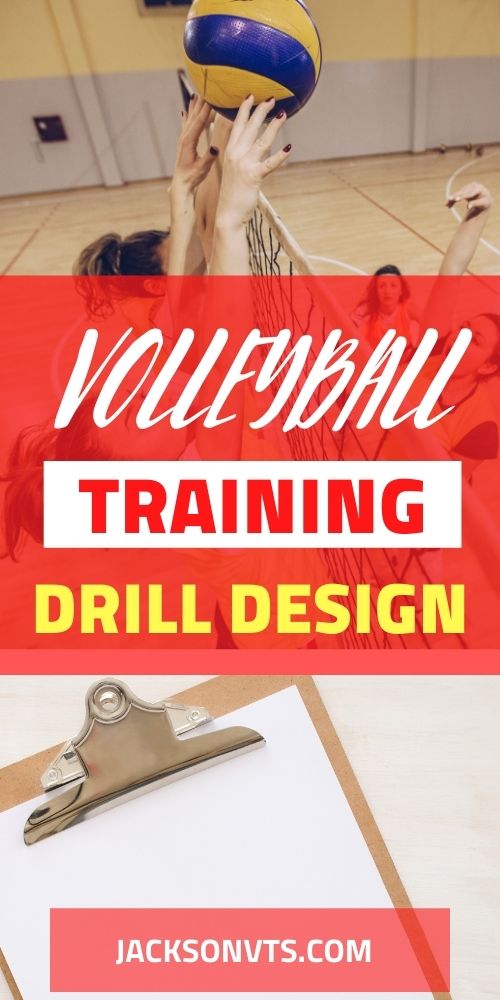Developing your volleyball skills and techniques to win
All the volleyball drills and exercises on the following page are designed to develop fundamental skills.
It’s extremely important as an athlete or coach that you execute them with proper technique in order to avoid injury.
To reduce the risk of possible injury, consult your doctor before beginning any exercise or skill development program.
Spiking Drills
Arm Snaps: Two athletes work together with one ball. Facing each other on the sidelines, players toss the ball up in the air with two hands and then spike the ball down into the middle of the court. They should work on a high contact point and wrist snap.
Spiking a Volleyball
Standing Spikes: Coach tosses balls for the hitters about 10 feet back from the net. The hitter should have the hitting elbow back and up. The hitter steps to where the ball is falling and uses the hitting arm swing to hit it over the net into the court. The hitter focuses on an “elbow to wrist” contact.
Arm Swings on the Wall: Two athletes work together with one ball. One athlete stands facing the wall (about 15 feet back from it) with his/her hitting elbow up and behind his/her shoulder and the non-hitting arm up in the air. The partner is standing in front of the hitter and to the side of the hitters arm. The partner with the ball tosses it up in front of the hitter for him/her to spike at the wall. The hitter should be aiming at something on the wall that is about net height.
Box Spiking: Perhaps the most important of all spiking volleyball drills are the ones that involve spiking on a box. Players should spike on a box every practice. When on a box, players should focus on the contacting the ball high, with arm vertical, and contacting in such a manner that makes the ball spin (topspin).

Passing a Volleyball
Drills for Passing and Digging
It’s important that your volleyball drills involve mainly passing balls that are coming from across the net. For example, partner drills that involve playing the ball from a partner on the same side of the net aren’t “game like” and are much less valuable.
Reaction Drill: One partner (thrower) holds the ball overhead with two hands. (Make sure he/she does this! It makes a difference for this drill!) The other partner is in ready position about four steps away from the thrower. The thrower throws the ball to either side of the passer, or in front of him/her, to make him/her take a step to pass the ball. The thrower should just flex the wrists forward to throw the ball, not pull his/her arms down.
Reaction Off Of Wall: One player (digger) faces the wall about 15 feet back. The other player (tosser) stands behind the digger about five feet. The tosser says, Go! and then throws the ball at the wall, about 10-feet high on the wall. The digger reacts to the ball bouncing off of the wall and digs it up.
King-of-the-Court: This drill can be used for all aspects of the game. Most players love this game! The game begins with the Challengers side serving over to the Kings/Winners side. There is only one rally to determine who will stay on the court. Which ever side wins goes to (or stays on) the Kings/Winners side. The loser of the rally should shag the ball. This game can be played with lots of variations: No jumping; jumping from behind the 10-foot line only, with twos, threes or more players, no serving, but coach tosses the ball in, etc.
If you enjoyed these tips and would like to keep it close to you at any time, just save this pin to your Pinterest Volleyball Training Board.

Setting Partner Drills for Two People and One Ball
When learning volleyball drills for setting, really emphasize getting in position and using good setting technique.
Setting a Volleyball
Setting Progressions: The focus of this drill is on setting with correct hand positions, then slowly work up to quick releases. Have players pair up. One player tosses the ball and the other player catches it in setting position. The players stand parallel to the net to simulate game like setting.
Players then use the following steps…
- One partner tosses the ball to the setter, who catches it and checks to determine if he or she needs to make any change in hand position.
- Once hand position is determined to be good, the setter push-sets the ball back to partner.
- Partner continues to toss the ball to the setter forcing the setter to use quick footwork to get in position to set.
- Partners switch after 10 reps.
- Once both players are comfortable, repeat the steps above with players setting the ball instead of catching and pushing.
- Once players have become confident with the setting and catching routine, the catching phase can be eliminated. Players should practice setting in a manner which the officials won’t call a lift or carry. Adjust the distance between partners to learn shorter and longer sets. One option is to have one player set the ball and the other player try to duplicate the set height.
Toss and Set: One person tosses ball for the partner to set back to the tosser. The toss can be to the partner, to either side, short or deep to move the partner around.
Over the Net: Remember, the best volleyball drills are the ones that involve the ball coming over the net. For this next drill, each partner is two steps back from the net. One partner tosses the ball over the net to his/her partner. The partner sets the ball back, high over the net. If the athletes are capable to keep setting back and forth over the net, have the partners count how many contacts they can make in a row without an error.
Serving Drills
You don’t want to give away the intent of the serve. So when performing serving volleyball drills, players should avoid changing the serving motion when serving to different spots on the court.
The motion remains the same and it’s the speed of the server’s arm and subsequent contact that allows the ball to travel short or deep.
Serving a Volleyball
For these volleyball drills, partners face one another across the net.
- One player serves a flat serve, a floater or topspin serve that crosses the net no higher than midway up the antenna.
- The partner who first receives the ball returns the serve by duplicating the initial serve.
- The second serve taken by each player should look exactly the same, except that the arm swing should decelerate before contact. The ball should cross the net with reduced speed, land inside the 5-foot line and bounce one time to the partner.
- Each player takes 6 serves at this distance.
- Next, each player moves back 3 to 5 feet and repeats steps 1 through 5. If players have moved 5 feet each time, they end up serving from the 20 foot line for a total serving distance of 40 feet. The goal of the second serve of each pair would be to land the ball inside the 10 foot line, preferably even closer to the net.
For all your volleyball drills, getting in position and using good form is key. You will often hear coaches yell, “get your feet to the ball!”. This is because the best players are the ones that are the best at getting in position. Always focus on improving anticipation skills and mastering proper technique while practicing volleyball drills.
Volleyball Drills Related Pages
Conditioning Drills
Volleyball conditioning drills to get your team in shape. Do you know how to get in shape for volleyball? Conditioning drills help your players get faster, stronger, and jump…
Hitting Drills
Volleyball hitting drills for spiking. The following beginner drills are very important for learning how to spike. A vertical arm position and creating topspin are key…
Setting Drills
Volleyball setting drills train volleyball players to set consistently and accurately. Just like most skills in volleyball, mastering technique first is extremely important. Performing repetition after repetition without mastering…
Serving Drills
Volleyball serving drills for beginners are important. You don’t want to just serve to put the ball in play. Players need to practice focusing on serving with purpose. The more specific you focus…
Passing Drills
Volleyball passing drills. When choosing drills, consider player weaknesses and strengths. Monitor each players passing during the season and create appropriate drills. The serves players see in competition…
Drills for Passing
Volleyball drills for passing are important because receiving is a critical volleyball skill. Without pinpoint passing accuracy, there can’t be effective quick attacks. Good serve reception requires…
Fun Practice Games
Fun volleyball games are a fun way for kids to discover what to do in a game situation. The discovery method empowers players to solve problems that arise which is a large part of the fun in learning volleyball…
Practice Drills
Volleyball practice drills for improving team performance. Use these strategies and develop skills to win more games.
Home › Volleyball Drills
